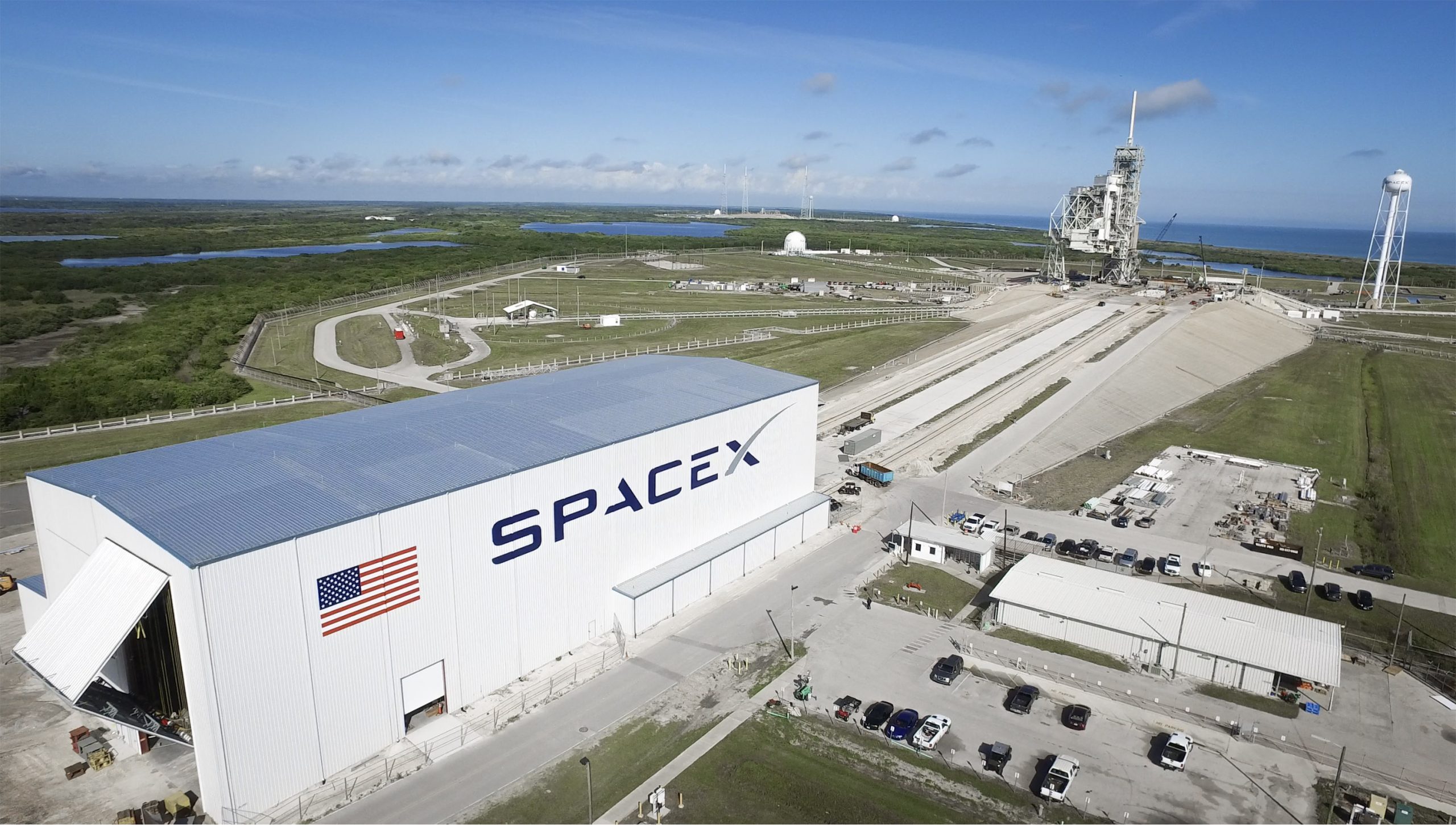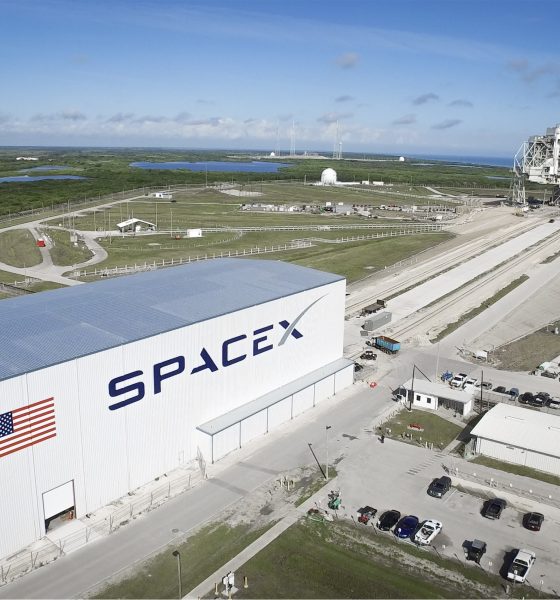Kennedy Space Center and Cape Canaveral Air Force Station were largely spared the brunt of Hurricane Irma due to last-second changes to its projected path. Both SpaceX and ULA have since reported that damages to their facilities are minimal and unlikely to contribute to any delays in upcoming launches, of which SpaceX has several.
Several days before Hurricane Irma reached Florida, the storm projected to make landfall almost directly on Cape Canaveral, stoking fears of spaceflight journalists and forcing the evacuation of several living on the Space Coast. While Irma’s course veered southeast as it neared the Space Coast, Cape Canaveral eventually experienced some level of heavy rain, flooding, and high winds on Sunday and Monday. A NASA flyover of Kennedy Space Center illustrated this best, with very little damage visible from the helicopter, aside from some limited flooding and some mild damage to the roofs of several buildings.
Modern facilities at the Cape are generally built to tolerate Category 5 winds of 150 mph, and Irma appeared to potentially pose a threat to even those structures in the early days of forecasts. However, with maximum recorded winds of around 100 mph from Irma, worries more centered around tornadoes formed by the hurricane, as well as more temporary structures that were under construction. Gwynne Shotwell commented on this earlier today, speaking at the World Satellite Business Week meeting in Paris, France. SpaceX’s President said that LC-39A and SLC-40 looked fine in initial flyovers performed by the company. Her main concern was an array of construction materials and temporary shelters currently at SLC-40 that were exceptionally vulnerable to hurricane conditions.

SpaceX’s LC-39A launch pad seen from a NASA helicopter on 9/12. Thankfully, no damage is readily apparent. (NASA)
Following natural (and unnatural) disasters at Kennedy Space Center and CCAFS, access is restricted to a select crew of emergency reaction teams that are tasked with combing through the myriad facilities and cataloging any serious damage and potential dangers for workers. Once they are finished with their surveys, nonessential personnel are allowed to return to their workplaces and begin their own surveys and repairs. CCAFS and the 45th Space Wing began allowing nonessential personnel back into the facility on Tuesday, while Kennedy Space Center may open its gates on Thursday. Once allowed back in, SpaceX can begin their own damage survey and conduct any necessary repairs.
The company is planning to conduct its next East Coast launch as early as October 2nd, with a second October launch from Florida expected no earlier than October 14th. SpaceX is also scheduled to launch Iridium’s third group of ten NEXT satellites from California on October 4th, so the company has an extremely busy month ahead. Thankfully, with more than two weeks between now and next launch, SpaceX will likely have plenty of time to undertake all necessary repairs, so long as damage is minimal.
7th and 8th sats for Launch #3 just pulled out to head towards VAFB. I feel better knowing there's a guard riding along to protect them! pic.twitter.com/6NppidPhDh
— Matt Desch (@IridiumBoss) September 4, 2017
While SpaceX was spared, those more directly in the path of Irma were not nearly as lucky. In Florida, nearly 25% of all residents were without power for days, and many millions are still waiting for utility companies to repair widespread damage to their infrastructure. Many homes have undoubtedly been destroyed beyond repair. Floridans were largely spared from the deadly threat of Irma by widespread evacuation orders on the East coast, but most residents of islands along Irma’s path had nowhere to evacuate. Dozens of deaths have been reported in Barbados, the Virgin Islands, and other islands. Many more were killed and injured in Cuba. Recovery from Irma will undoubtedly take many years.

News
Tesla FSD successfully completes full coast-to-coast drive with zero interventions
Tesla community members celebrated the milestone on X, and the feat earned praise from some of the electric vehicle maker’s executives.

A Tesla owner has successfully completed a full coast-to-coast drive across the United States on Full Self-Driving (FSD) Supervised. The trip was accomplished with zero interventions.
Tesla community members celebrated the milestone on X, and the feat earned praise from some of the electric vehicle maker’s executives.
FSD Coast-to-Coast
The coast-to-coast feat was accomplished by Tesla owner Davis Moss, who drives a stealth gray Model 3 with AI4 hardware. Based on data from the FSD database and a community tracker, the last 10,638.8 miles Moss drove in his Model 3 were completed using FSD 100% of the time. His vehicle is equipped with FSD v14.2.1.25, which was installed 12 days ago.
As per Moss in a celebratory post on X, his Model 3 was able to complete a full coast-to-coast drive across the United States in 2 days and 20 hours. His trip started at the Tesla Diner in Los Angeles, CA, and it ended in Myrtle Beach, SC. Overall, his trip spanned 2,732.4 miles.
“This was accomplished with Tesla FSD V14.2 with absolutely 0 disengagements of any kind even for all parking including at Tesla Superchargers,” Moss stated in his post. He also added in later comments that there were zero close calls during the trip.
Tesla community celebrates
The FSD milestone trip was widely lauded by members of the Tesla community, especially since a coast-to-coast drive with zero interventions has been cited by Elon Musk as a target since October 2016, when Autopilot 2.0 was unveiled. At the time, Musk initially estimated that a coast-to-coast drive across the United States should be possible by the end of 2017. Considering Moss’ feat in his Model 3, it appears that Elon Musk’s estimate was not impossible at all. It was just late.
Musk himself celebrated the milestone on X, and so did Tesla VP of AI Software Ashok Elluswamy, who wrote “World’s first fully autonomous coast-to-coast drive, done with Tesla self-driving v14. Congrats and thank you @DavidMoss!” in a post on X. The official Tesla North America account also celebrated the feat, writing “First Tesla to drive itself from coast to coast w/ FSD Supervised. 0 interventions, all FSD” on X.
Elon Musk
Elon Musk: Tesla Model Y is world’s best-selling car for 3rd year in a row
The Model Y has now established an impressive streak that would otherwise have been impossible before Tesla.

Elon Musk has announced that the Tesla Model Y has become the world’s best-selling car by volume for the third consecutive year, capping 2025 with another dominant performance.
The Model Y has now established an impressive streak that would otherwise have been impossible before Tesla.
Three years in a row
Musk posted on X: “Tesla Model Y is now officially the world’s best-selling car for the third year in a row!” The CEO’s comment echoed an update that Tesla included in its 2025 recap, which highlighted, among other things, the Model Y’s incredible streak.
The Model Y has held the title since 2023, outperforming traditional leaders like the Toyota RAV4 and Corolla thanks to its bang-for-the-buck nature and its stellar combination of practicality, performance, and tech. The Model Y is also lauded as one of the safest vehicles on the road, making it an ideal choice for families in key markets such as China.
An impressive 2025
The Model Y’s sales feat in 2025 is especially impressive considering the introduction of the vehicle’s new variant. Tesla’s changeover to the new Model Y across its global factories resulted in sales being paused for some time in the first quarter. As per Tesla’s Q1 2025 vehicle delivery and production report, “the changeover of Model Y lines across all four of our factories led to the loss of several weeks of production in Q1.”
This suggests that the Model Y’s sales remained strong in 2025 to the point where it could still claim the title of the world’s best-selling vehicle by volume, even with its sales being throttled during the first quarter of the year. It would then be interesting to see just how far the Model Y can go in 2026, especially considering the rollout of new variants like the six-seat extended wheelbase Model Y L, the affordable Model Y Standard, and the top-tier Model Y Performance.
News
Tesla shares epic 2025 recap video, confirms start of Cybercab production
The cinematic montage, posted by the official Tesla account on X, celebrated the company’s progress in EVs, energy, and Robotaxi development.

Tesla has released an epic year-in-review video for 2025, recapping some of its major achievements from refreshed models to autonomy breakthroughs and production ramps.
The cinematic montage, posted by the official Tesla account on X, celebrated the company’s progress in EVs, energy, and Robotaxi development while looking ahead to an even bigger 2026.
Tesla’s 2025 highlights recap
Tesla has had a busy 2025, as highlighted in the recap video. The video opened with Elon Musk explaining the company’s pursuit of sustainable abundance. A number of milestones were then highlighted, such as the rollout of FSD v14, Optimus’ numerous demos, the opening of the Tesla Diner in Hollywood, LA, the completion of the world’s first autonomous car delivery, and the launch of the Robotaxi network in Austin and the San Francisco Bay Area.
Tesla also highlighted several of its accomplishments over the year. As per the company, the Model Y was the year’s best-selling vehicle globally again, and Teslas became more affordable than ever thanks to the Model 3 and Model Y Standard. Other key models were also rolled out, such as the refreshed Model S and X, as well as the new Model Y, the new Model Y Performance, and the six-seat, extended wheelbase Model Y L.
The Megablock was also unveiled during the year, and the Supercharger Network grew by 18%. Over 1 million Powerwalls were also installed during the year, and the Cybertruck became the first EV truck to get both an IIHS Top Safety Pick+ award and an NHTSA 5-Star safety rating.
Cybercab production confirmed
Interestingly enough, Tesla also confirmed in its 2025 recap video that the production of the Cybercab has started. This bodes well for the vehicle, as it could result in the vehicle really being mass-produced in the first half of 2026. Elon Musk confirmed during the 2025 Annual Shareholder Meeting that Cybercab production should earnestly start around April 2026.
Musk has also noted that the Cybercab will be Tesla’s highest-volume vehicle yet, with the company aiming for an annual production rate of about 2 million units. “If you’ve seen the design of the Cybercab line, it doesn’t look like a normal car manufacturing line,” Musk said earlier this year. “It looks like a really high-speed consumer electronics line. In fact, the line will move so fast that actually people can’t even get close to it.”









